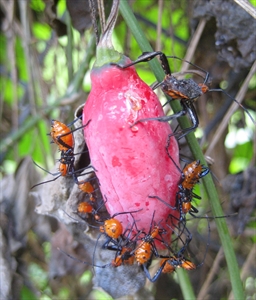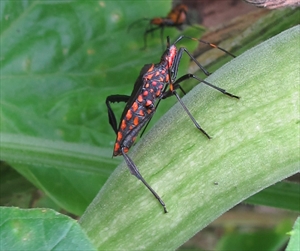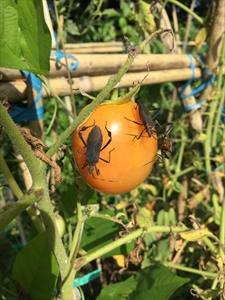Leaf-footed bug, squash bug
Pacific Pests, Pathogens, Weeds & Pesticides - Online edition
Pacific Pests, Pathogens, Weeds & Pesticides
Squash leaf-footed bug (165)
Leptoglossus species; Leptoglossus gonagra (previosuly known as Leptoglossus australis) is the common species in the Pacific islands.
Asia, Oceania. It is recorded from Australia, American Samoa, Fiji, French Polynesia, Guam, Federated States of Micronesia, North Mariana Islands, Palau, Papua New Guinea, Samoa, Solomon Islands, Tonga, Vanuatu, and Wallis & Futuna.
Squash, snake gourd, melon, cucumber, pumpkin and other cucurbits. Many other plants, including, citrus, eggplant, guava, legumes, passionfruit and tomato, are reported as hosts.
Damage is caused by both nymphs and adult bugs sucking sap from stems and tender fruits. The bugs feed using their long tube-like mouths to draw sap from stems, fruits and seeds. Stems turn yellow-brown and they may die if infestations are high. Feeding on fruits causes them to shrivel, rot and drop.
The eggs are laid on the leaves and stems, and even on the tendrils, in batches of about 30. They hatch in 6-7 days. There are five nymph stages over 40-50 days. Young nymphs are reddish, but as they pass from one moult to the next they become darker (Photo 1). The adults are about 18-24 mm long, black or dark brown, with a curved orange line behind the head, and distinctive orange-red spots on the under surface and sides (Photo 2). They have very long sucking mouthparts, almost as long as their bodies, which they use to feed on fruit of all ages (nymphs feed on stems and leaves).
A distinctive feature of the bug are the outgrowths on the legs of the late stage nymphs and the adults; these are the reason for the common name - leaf-footed bug (Photos 3-5) . The adults live for about 2 weeks.
The bugs are not considered major pests, and only occasionally reach numbers that cause economic damage. Plants in the citrus, cucumber and passionfruit families are most affected.
Look for a large black slow-moving bug with orange spots on the sides and distinctive outgrowths on the hind legs. Look for the nymphs which are red at first, becoming brown as they develop. Look for the very long mouthparts that adults insert to feed on fruit of all ages.
NATURAL ENEMIES
There are no reports of predators or parasitoids attacking Leptoglossus in Pacific island countries. Elsewhere, reduviids (assassin bugs), mantids (praying mantis), spiders and wasps are known to destroy eggs and prey on nymphs.
CULTURAL CONTROL
Before planting:
- Do not plant crops next to those that are already infested with the bug.
During growth:
- Handpick the insects. They can be caught easily as they are relatively slow moving, especially in the cooler early morning or late evening.
After harvest:
- Collect and burn as much of the crop as possible after harvest.
CHEMICAL CONTROL
It is unlikely that infestations would reach levels where chemical control would be necessary, or economically justified. If it is necessary, try sprays of:
- Biorational insecticides:
- PDPs, derris or pyrethrum.
- Microbial insecticides, abamectin and spinosad.
- Pyrethroids or malathion, but these will have greater impact on natural enemies.
--------------------
Note, derris (Derris species) contains rotenone, an insecticide, often used as a fish poison; it should be used with caution. The commercial derris insecticide is made from Derris elliptica.
____________________
When using a pesticide, always wear protective clothing and follow the instructions on the product label, such as dosage, timing of application, and pre-harvest interval. Recommendations will vary with the crop and system of cultivation. Expert advice on the most appropriate pesticide to use should always be sought from local agricultural authorities.
AUTHOR Grahame Jackson
Information from Ingels C, Haviland D (2014) Pest notes: Leaffooted bug. UC/IPM. ANR Publication 74168. (http://ipm.ucanr.edu/PMG/PESTNOTES/pn74168.html). and from Leptoglossus gonagra (2020). Wikipedia. (https://en.wikipedia.org/wiki/Leptoglossus_gonagra). Photos 1&2 Graham Teakle, Canberra. Photos 3-5 Mani Mua, SPC, Sigatoka Research Station, Fiji.
Produced with support from the Australian Centre for International Agricultural Research under project PC/2010/090: Strengthening integrated crop management research in the Pacific Islands in support of sustainable intensification of high-value crop production, implemented by the University of Queensland and the Secretariat of the Pacific Community.








